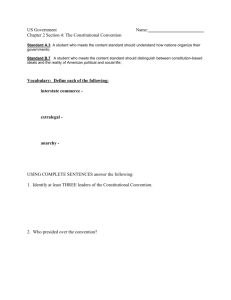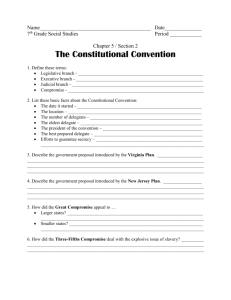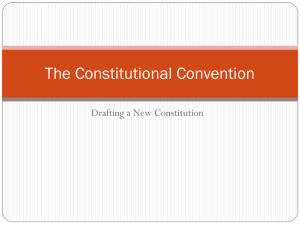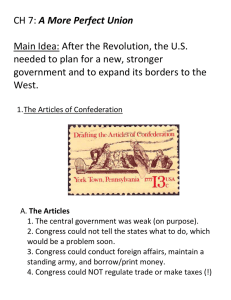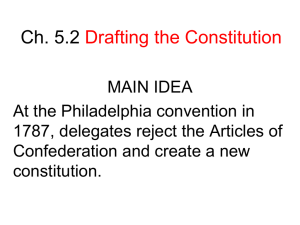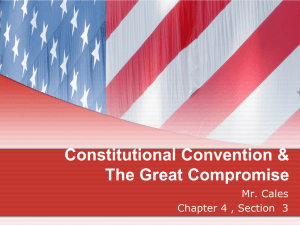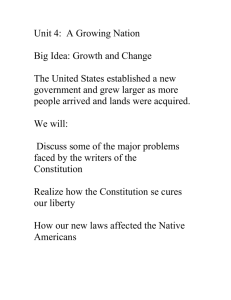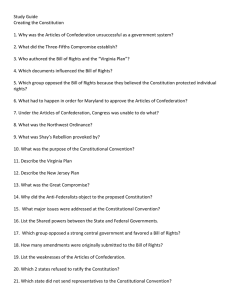Constitutional Convention
advertisement
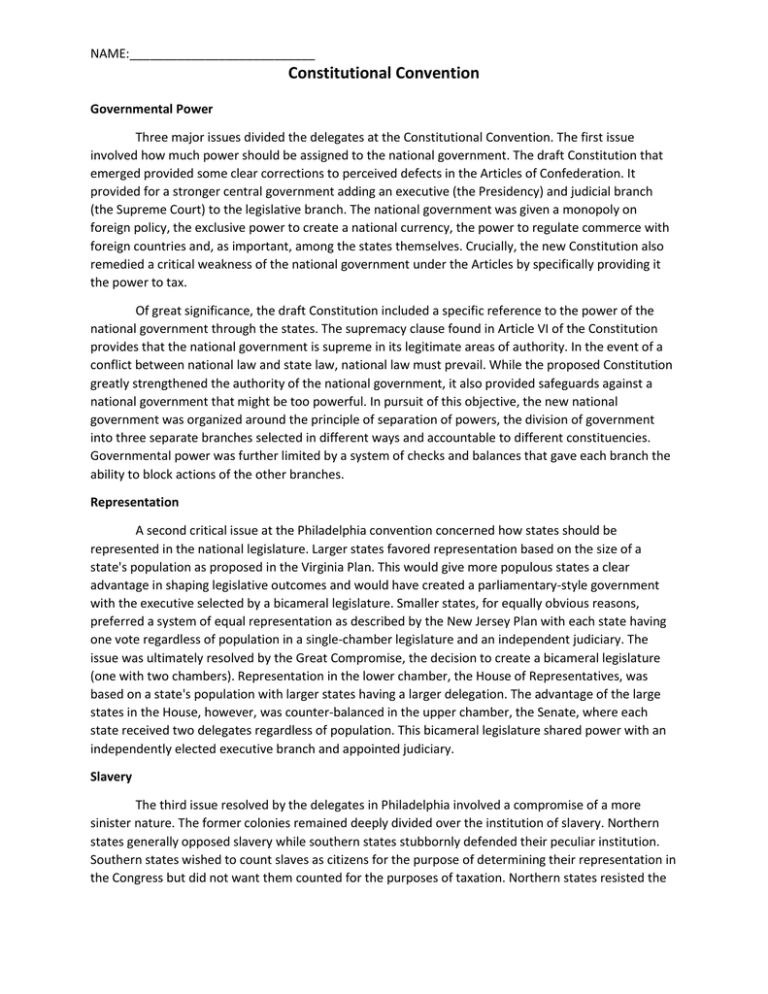
NAME:___________________________ Constitutional Convention Governmental Power Three major issues divided the delegates at the Constitutional Convention. The first issue involved how much power should be assigned to the national government. The draft Constitution that emerged provided some clear corrections to perceived defects in the Articles of Confederation. It provided for a stronger central government adding an executive (the Presidency) and judicial branch (the Supreme Court) to the legislative branch. The national government was given a monopoly on foreign policy, the exclusive power to create a national currency, the power to regulate commerce with foreign countries and, as important, among the states themselves. Crucially, the new Constitution also remedied a critical weakness of the national government under the Articles by specifically providing it the power to tax. Of great significance, the draft Constitution included a specific reference to the power of the national government through the states. The supremacy clause found in Article VI of the Constitution provides that the national government is supreme in its legitimate areas of authority. In the event of a conflict between national law and state law, national law must prevail. While the proposed Constitution greatly strengthened the authority of the national government, it also provided safeguards against a national government that might be too powerful. In pursuit of this objective, the new national government was organized around the principle of separation of powers, the division of government into three separate branches selected in different ways and accountable to different constituencies. Governmental power was further limited by a system of checks and balances that gave each branch the ability to block actions of the other branches. Representation A second critical issue at the Philadelphia convention concerned how states should be represented in the national legislature. Larger states favored representation based on the size of a state's population as proposed in the Virginia Plan. This would give more populous states a clear advantage in shaping legislative outcomes and would have created a parliamentary-style government with the executive selected by a bicameral legislature. Smaller states, for equally obvious reasons, preferred a system of equal representation as described by the New Jersey Plan with each state having one vote regardless of population in a single-chamber legislature and an independent judiciary. The issue was ultimately resolved by the Great Compromise, the decision to create a bicameral legislature (one with two chambers). Representation in the lower chamber, the House of Representatives, was based on a state's population with larger states having a larger delegation. The advantage of the large states in the House, however, was counter-balanced in the upper chamber, the Senate, where each state received two delegates regardless of population. This bicameral legislature shared power with an independently elected executive branch and appointed judiciary. Slavery The third issue resolved by the delegates in Philadelphia involved a compromise of a more sinister nature. The former colonies remained deeply divided over the institution of slavery. Northern states generally opposed slavery while southern states stubbornly defended their peculiar institution. Southern states wished to count slaves as citizens for the purpose of determining their representation in the Congress but did not want them counted for the purposes of taxation. Northern states resisted the NAME:___________________________ Constitutional Convention admittedly cynical attempt by southern states to count slaves for representation but with equal ethical opportunism wanted slaves counted for apportionment of national taxes. The resulting compromise remains a notorious (though now irrelevant) feature of the US Constitution but doubtless saved the United States as a unified nation. The Three-Fifths Compromise determined that slaves would be counted as three-fifths of a person for both representation and taxation. It was also agreed that Congress could not ban the importation of slaves until 1808 and that northern states would be obligated to return fugitive slaves. Ironically, however, the words "slave" and "slavery" are not mentioned in the Constitution. The Thirteenth Amendment's ratification in 1865, outlawing slavery, makes the ThreeFifths Compromise legally void. 1. Identify each of the three major issues addressed at the Constitutional Convention AND the solution to each issue. Explain the solution AND provide the name of what we refer to it by. a. Issue #1 & Solution: b. Issue #2 & Solution: c. Issue #3 & Solution: 2. What kind of men attended the convention in Philadelphia and in what ways do you think this impacted their ultimate decision making? 3. Choose one of the three issues brought up and “solved” at the convention and explain how and why you believe it is still an issue in our political system today. How would you go about solving this issue once and for all?
